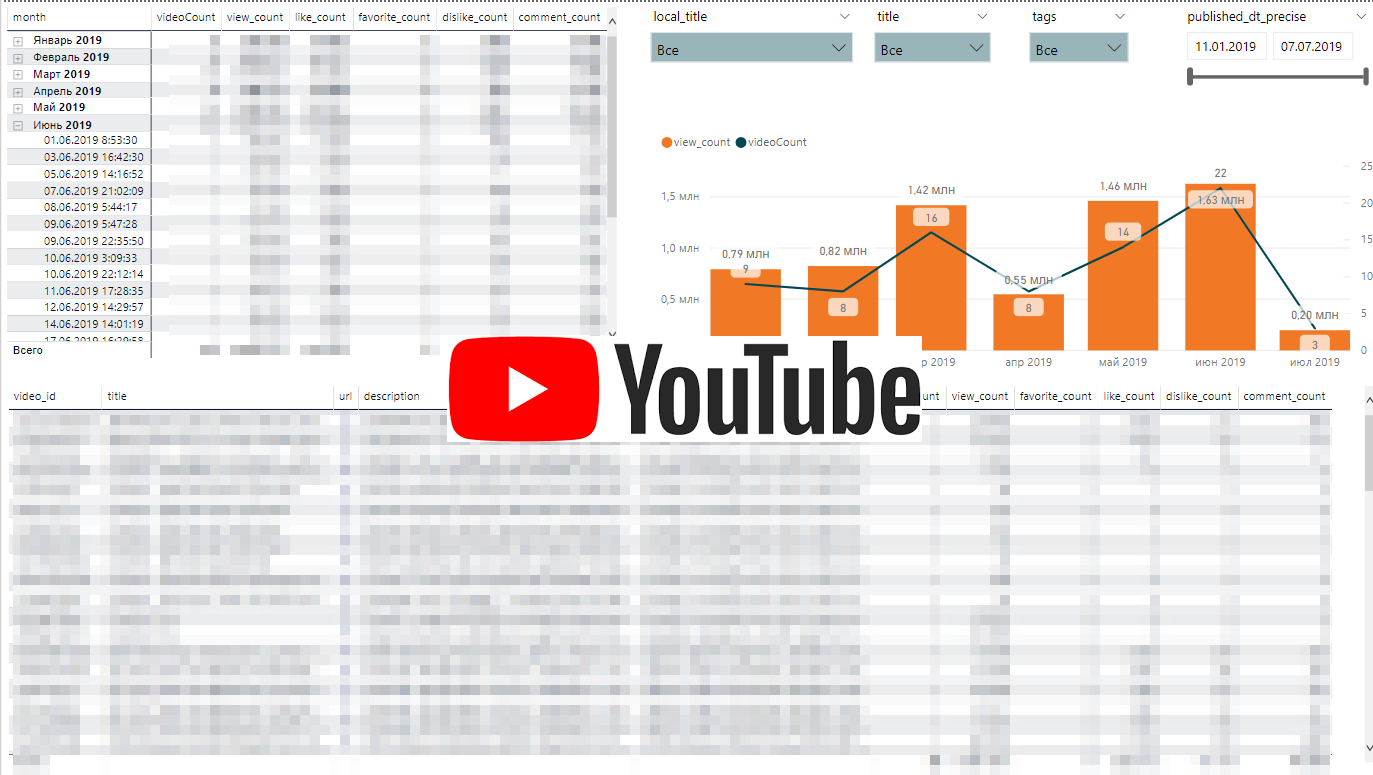Designing dashboards for web analytics e-commerce site. Part 4: Youtube Channel
It’s easy to calculate how much traffic came from the YouTube channel. For example, go to the Yandex Metrics or Google Analytics counter. And you try to find out what happened to your video on the channel. Who looked at him, who added to favorites, and who disliked. But to unload such data, you will need a Python script.

The dynamics of Youtube activities
The Youtube API is quite simple. We will upload a list of playlists and upload statistics for each playlist for the video.
The channel identifier can be found in the page code. You can read about obtaining the access key here . Create a report_client class and define procedures in it.
Next, to get the unload, we need to initialize the class and start the unload.
Articles from the cycle:

The dynamics of Youtube activities
The Youtube API is quite simple. We will upload a list of playlists and upload statistics for each playlist for the video.
YOUTUBE_API_URL = 'https://www.googleapis.com/youtube/v3' YOUTUBE_API_KEY = '...' YOUTUBE_CHANNEL_ID = '...'
The channel identifier can be found in the page code. You can read about obtaining the access key here . Create a report_client class and define procedures in it.
class report_client: def __init__(self, api_url, api_key, proxies): self._url = api_url self._key = api_key self._proxies = proxies def req_video(self, channel_id = YOUTUBE_CHANNEL_ID): url = ('{0}/activities?channelId={1}&key={2}&part=snippet%2CcontentDetails&maxResults=50') r = requests.get(url.format(self._url, channel_id,self._key) , proxies = self._proxies) parsed = json.loads(r.text) res_df = pd.DataFrame(columns=['video_id']) for i in parsed['items']: temp = {} if 'upload' in i['contentDetails']: temp['video_id'] = i['contentDetails']['upload']['videoId'] res_df = res_df.append(temp, ignore_index=True) return res_df def req_playlist(self, channel_id = YOUTUBE_CHANNEL_ID): url = ('{0}/playlists?channelId={1}&key={2}&part=snippet%2CcontentDetails&maxResults=50') r = requests.get(url.format(self._url, channel_id, self._key) , proxies = self._proxies) parsed = json.loads(r.text) res_df = pd.DataFrame(columns=['playlist_id', 'playlist_name']) for i in parsed['items']: temp = {} temp['playlist_id'] = i['id'] temp['playlist_name'] = i['snippet']['title'] res_df = res_df.append(temp, ignore_index=True) return res_df def req_playlist_stat(self, playlist_id, channel_id = YOUTUBE_CHANNEL_ID): res_df = pd.DataFrame(columns=['video_id', 'playlist_id', 'playlist_name']) for i,k in playlist_id.iterrows(): url = ('{0}/playlistItems?playlistId={1}&key={2}&part=snippet&maxResults=50') r = requests.get(url.format(self._url, k['playlist_id'],self._key) , proxies = self._proxies) parsed = json.loads(r.text) for j in parsed['items']: temp = {} temp['video_id'] = j['snippet']['resourceId']['videoId'] temp['playlist_id'] = k['playlist_id'] temp['playlist_name'] = k['playlist_name'] res_df = res_df.append(temp, ignore_index=True) stop = 0 while 'nextPageToken' in parsed: url = ('{0}/playlistItems?playlistId={1}&key={2}&part=snippet&maxResults=50&pageToken={3}') r = requests.get(url.format(self._url, k['playlist_id'],self._key,parsed['nextPageToken']) , proxies = self._proxies) parsed = json.loads(r.text) for j in parsed['items']: temp = {} temp['video_id'] = j['snippet']['resourceId']['videoId'] temp['playlist_id'] = k['playlist_id'] temp['playlist_name'] = k['playlist_name'] res_df = res_df.append(temp, ignore_index=True) stop = stop + 1 if stop == 1: break return res_df def req_stat(self, video_id): res_df = pd.DataFrame(columns=['video_id','publishedAt','title','description',\ 'tags','local_title','viewCount','likeCount',\ 'dislikeCount','favoriteCount','commentCount'\ , 'playlist_id', 'playlist_name']) for i,k in video_id.iterrows(): url = ('{0}/videos?id={1}&key={2}&part=snippet,contentDetails,statistics,status&maxResults=50') r = requests.get(url.format(self._url, k['video_id'], self._key) , proxies = self._proxies) parsed = json.loads(r.text) if 'error' in parsed.keys(): break temp = {} if 'items' in parsed: if parsed['items']: temp['video_id'] = parsed['items'][0]['id'] temp['publishedAt'] = parsed['items'][0]['snippet']['publishedAt'] temp['title'] = parsed['items'][0]['snippet']['title'] temp['description'] = parsed['items'][0]['snippet']['description'] temp['playlist_id'] = k['playlist_id'] temp['playlist_name'] = k['playlist_name'] if 'tags' in parsed['items'][0]['snippet']: temp['tags'] = parsed['items'][0]['snippet']['tags'] if 'title' in parsed['items'][0]['snippet']['localized']: temp['local_title'] = parsed['items'][0]['snippet']['localized']['title'] if 'viewCount' in parsed['items'][0]['statistics']: temp['viewCount'] = parsed['items'][0]['statistics']['viewCount'] if 'likeCount' in parsed['items'][0]['statistics']: temp['likeCount'] = parsed['items'][0]['statistics']['likeCount'] if 'dislikeCount' in parsed['items'][0]['statistics']: temp['dislikeCount'] = parsed['items'][0]['statistics']['dislikeCount'] if 'favoriteCount' in parsed['items'][0]['statistics']: temp['favoriteCount'] = parsed['items'][0]['statistics']['favoriteCount'] if 'commentCount' in parsed['items'][0]['statistics']: temp['commentCount'] = parsed['items'][0]['statistics']['commentCount'] res_df = res_df.append(temp, ignore_index=True) return res_df
Next, to get the unload, we need to initialize the class and start the unload.
def youtube_reports(): a = report_client(YOUTUBE_API_URL,YOUTUBE_API_KEY,{}) method_rep = getattr(a, "req_playlist") playlist_id = method_rep() method_rep = getattr(a, "req_playlist_stat") video_id = method_rep(playlist_id) report_list = ["req_stat"] for rep in report_list: result_local_file_name = 'df_{0}.csv'.format(rep) method_rep = getattr(a, rep) df = method_rep(video_id) df.to_csv(r'C:\\Users\\User\\Desktop\\youtube.csv', index=False, header=True, sep='\t', quoting = csv.QUOTE_ALL, encoding="utf-8") to_sql_server(df, 'youtube_{0}'.format(rep)) youtube_reports()
Articles from the cycle:
- Designing dashboards for web analytics e-commerce site. Part 1: User Friendly Interface
- Designing dashboards for web analytics e-commerce site. Part 2: Email Newsletters. Strategic dashboard
- Designing dashboards for web analytics e-commerce site. Part 2: Email Newsletters. Operational dashboard
- Designing dashboards for web analytics e-commerce site. Part 3: SEO Channel
All Articles